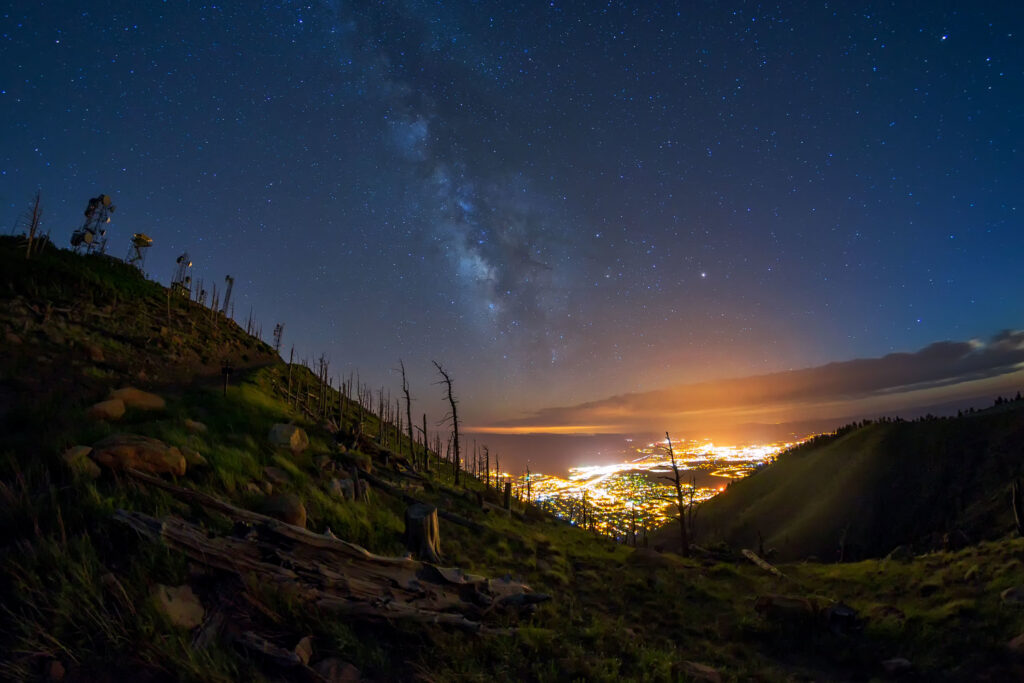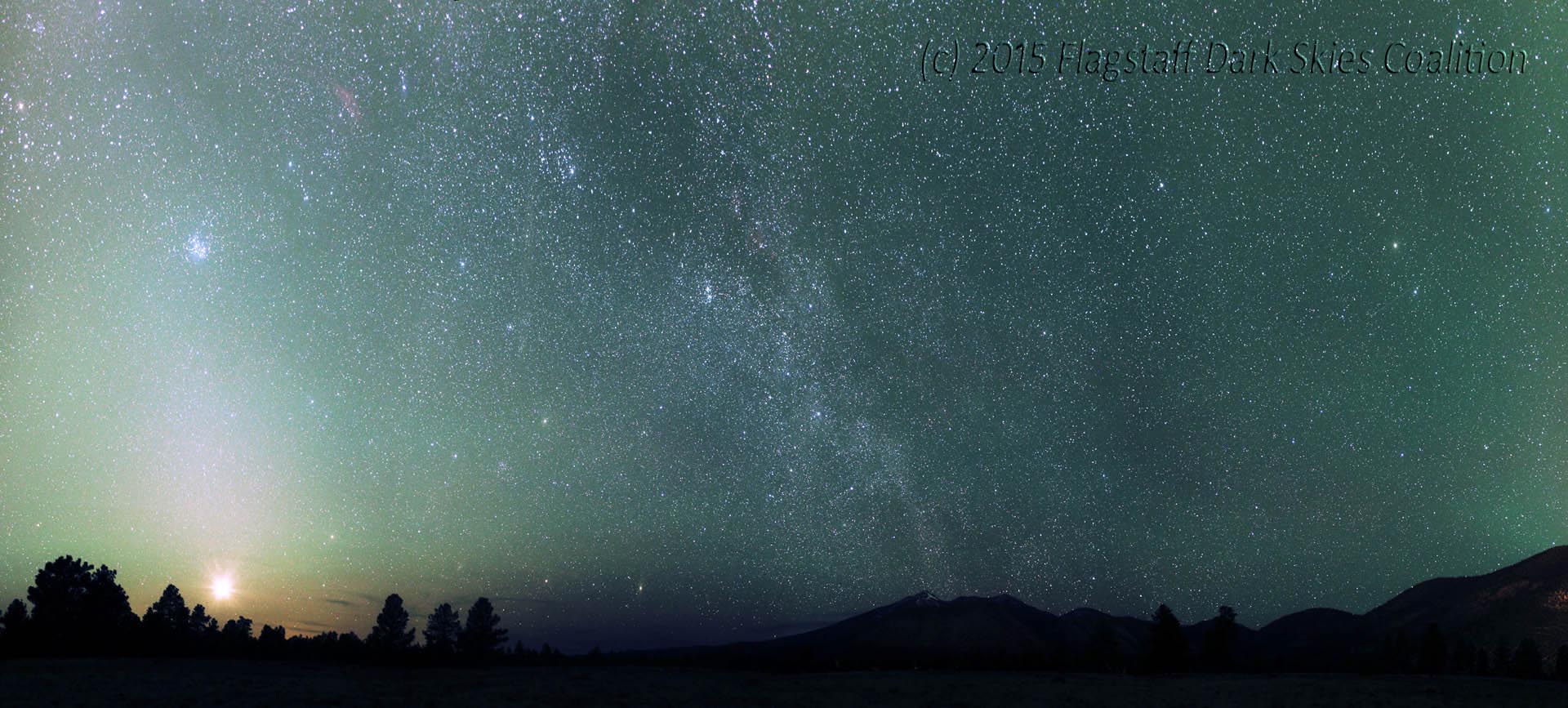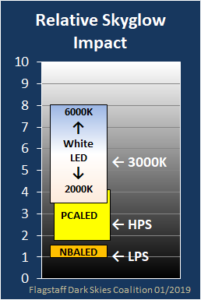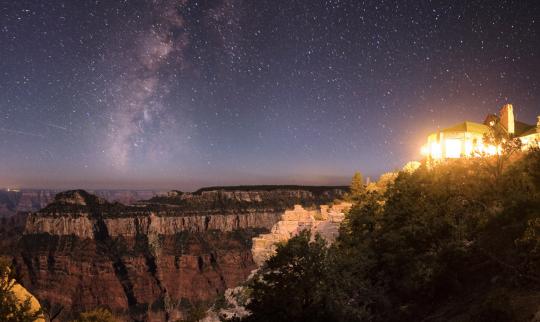
Light pollution is taking our stars. In 2014, light pollution was so pervasive that nearly 80% in North America, and 60% of Europeans, lived where the Milky Way was no longer visible over their homes1. And it has been getting worse since – with light pollution estimated to be doubling every eight years2. Clearly, strategies to address light pollution advocated by dark sky advocates and organizations are not working.
In contrast, other more difficult environmental degradation is being reduced. Since 1980, carbon dioxide emissions have been reduced by 88%; nitrogen dioxide by 68% and sulfur dioxide by 95%3, despite a population that has increased by more than 50%.
But in Flagstaff, Arizona, population over 77,000, the Milky Way is visible over downtown, and light pollution has not been increasing. Artificial brightness of Flagstaff’s night sky is over 90% fainter than over similar cities without effective light pollution control4.
It is not magic – it is accomplished by light pollution control strategies that any community can implement. And it is a vital message for a world yearning to see the stars.
1 Falchi et al., Science Advances v2, 2016 2 Kyba et al, Science v379, 2023 3 U.S. EPA Air Quality – National Summary 4 Pipkin et al., AAS #279, 2017
![]()
Our Vision
FDSC envisions a world in which everyone, regardless of socioeconomic status, can see the Milky Way in a dark sky that is cherished by their community and beneficial for all life.
Our Mission
• To reconnect people to the awe and wonder of a starlit sky.
• To nurture and celebrate the dark-sky ethos of Flagstaff and northern Arizona.
• To educate and advocate for the restoration of starlit skies in other communities, using Flagstaff as a model
The Flagstaff Solution
Night skies do not need to get relentlessly brighter! Flagstaff has proven it!
Flagstaff sky glow has been measured as more than 90% less than other towns of similar size. This result was achieved with no more magic than effective application of three strategies to protect night skies
- Amber spectral standard – true PC amber or narrowband amber lighting for most area lighting, not warm-white or low CCT white
- Shielding – Light downward to the ground, not upwards or sideways
- Limits on total lighting amounts – to prevent over lighting
Nonetheless, these simple approaches are much too rarely effectively applied. The Flagstaff Dark Skies Coalition is documenting in detail the processes and standards that have led to this result – The Flagstaff Solution – to provide vital guidance for other communities to take advantage of what we have learned to protect, even restore, their own night skies – to bring the Milky Way home!
See this essay Time for the Next Step – Night Sky Restoration by FDSC President Christian Luginbuhl.
— Henry Beston, The Outermost House (1928)

 Most discussions about limiting the light pollution impacts of the new white LED lighting revolve around the “correlated color temperature” – or “CCT” of the lights. CCT is a number that describes the “hue” of a white light – is it “warm” white (~2700 K CCT), “neutral” white (~4000 K CCT), or “cool” white (~5000 K CCT)? But CCT limits are the wrong approach to protecting dark skies, because CCT does not accurately indicate how much light pollution a light will cause. Even low-CCT white LEDs (e.g. the IDA-recommended 3000K CCT) have lumen-for-lumen sky glow impacts twice that of HPS, 3X greater than good PC amber LED, and over 5X worse than the dark sky gold-standard LPS or NBA LED! (See our page here for documentation of these ratios.) Do not accept the argument that says “low CCT white LEDs protect dark skies because light pollution will only get 2X worse than it is now, and this is an improvement because it might have gotten 5X worse!” To prevent continued degradation to our starry skies we must set our standards higher. There are practical solutions that will achieve true protection – see our pages on LED Lighting and Dark Skies, and FDSC “First Dark-Sky City” lighting recommendations – Commercial and Roadway Lighting Tips.
Most discussions about limiting the light pollution impacts of the new white LED lighting revolve around the “correlated color temperature” – or “CCT” of the lights. CCT is a number that describes the “hue” of a white light – is it “warm” white (~2700 K CCT), “neutral” white (~4000 K CCT), or “cool” white (~5000 K CCT)? But CCT limits are the wrong approach to protecting dark skies, because CCT does not accurately indicate how much light pollution a light will cause. Even low-CCT white LEDs (e.g. the IDA-recommended 3000K CCT) have lumen-for-lumen sky glow impacts twice that of HPS, 3X greater than good PC amber LED, and over 5X worse than the dark sky gold-standard LPS or NBA LED! (See our page here for documentation of these ratios.) Do not accept the argument that says “low CCT white LEDs protect dark skies because light pollution will only get 2X worse than it is now, and this is an improvement because it might have gotten 5X worse!” To prevent continued degradation to our starry skies we must set our standards higher. There are practical solutions that will achieve true protection – see our pages on LED Lighting and Dark Skies, and FDSC “First Dark-Sky City” lighting recommendations – Commercial and Roadway Lighting Tips.Flagstaff Dark Skies Coalition
A dark, star-filled night sky is often thought of as important for astronomy or research. Though this is true, the grandeur of the night sky is much deeper and broader, and accessible to anyone. We find the beauty and meaning of natural night is best expressed by poets and writers, such as Henry Beston.
 Photo by Tyler Nordgren, courtesy of the Grand Canyon Association
Photo by Tyler Nordgren, courtesy of the Grand Canyon Association
Although astronomers and astronomy are important (some of our best friends are astronomers), protecting the night sky just for astronomers would be like protecting Grand Canyon just for geologists. Yet no one ever seems to think so narrowly about the Canyon; it is our hope that after looking through our website you may think more broadly about the night sky.
As the international dark sky movement began in Flagstaff in 1958, our community has always been keenly aware of the special value of the night sky. The Flagstaff Dark Skies Coalition and the greater community of Flagstaff are proud to remain world leaders in practical and successful dark sky protection.
